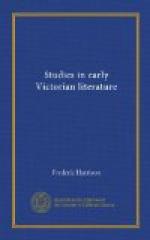This photographic realism of conversation is common enough now: but it has too often the defects of photography; it is bleared, coarse, and ill-favoured. As we all know, in the new realism a young woman and her lover talk thus: “Old gal! why so glum?” said he—“It’s my luck!” says she, and flings her straw hat on the floor. That is the new photographic style, but it does not please us of an older generation. Now Trollope makes his people utter such phrases as the characters he presents to us actually use in real life—or rather such phrases as they did use thirty years ago. And yet, although he hardly ever rises into eloquence, wit, brilliancy, or sinks into any form of talk either unnaturally tall, or unnaturally low,—still, the conversations are just sufficiently pointed, humorous, or characteristic, to amuse the reader and develop the speaker’s character. Trollope in this exactly hits the happy mean. Like Mr. Woodhouse’s gruel, his conversations are “thin—but not so very thin.” He never attempts grandiloquence; but then he never sinks into the fashionable bathos of—“Sugar in your tea, dear?”—“Another lump, if you please,”—nor does he fall into the fashionable realism of—“Dry up, old man!” No! Trollope’s characters speaks with literal nature; and yet with enough of point, humour, vigour, to make it pleasant reading.
We may at once confess to his faults and limitations. They are plain enough, constant, and quite incapable of defence. Out of his sixty works, I should be sorry to pick more than ten as being worth a second reading, or twenty which are worth a first reading. Nor amongst the good books could I count any of the last ten years. The range of characters is limited to the clergy and professional men of a cathedral city, to the county families and the respectabilities of a quiet village, to the life of clubs, public offices, and Parliament in London, and to the ways of “society” as it existed in England in the third quarter of the present century. The plots are neither new nor ingenious; the incidents are rarely more than commonplace; the characters are seldom very powerful, or original, or complex. There are very few “psychologic problems,” very few dramatic situations, very few revelations of a new world and unfamiliar natures. There are some natural scenes in Ireland; now and then a cook-maid, a farmer, a labourer, or a clerk, come on the stage and play their short parts with faultless demeanour. But otherwise, the entire company appear in the frock-coats and crinolines of the period, and every scene is played in silk hats, bonnets, and regulation evening toilette.




